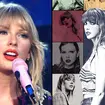Selfies "Fuelling Eating Disorders"
It's claimed 'selfies' are prompting a rise in the number of eating disorders.
A leading expert believes they're being fueled by the growing trend among young women for documenting their weight loss by taking pictures of their thinning frames and sharing them online.
Dr Alex Yellowlees from the Priory hospital group, the UK's largest provider of eating disorders treatments outside the NHS, said: "Some people will take repeated pictures of themselves at various stages of their illness, and send them to others.
"They want to keep a record of their illness and see for themselves, as it were, the progress they think they are making towards anorexia, but they will also transmit the images to other sufferers on occasions."
Dr Yellowlees said such competitive selfie dieting 'diaries' were contributing to damaging psychological pressures that can make anorexia and other potentially fatal illnesses worse.
He said the trend of sharing selfies was growing because of the number, and increasing use, of social media sites "which young people now find a completely natural form of communication".
In some cases, young women are encouraged to reduce their weight to dangerous levels by looking at so-called "thinspiration" websites, where they can compare their bodies with those of other extreme dieters.
Thinspiration websites can include blogs written by extreme dieters who upload their 'tips and tricks' to encourage others to lose weight.
Dr Yellowlees said pro-ana (anorexia) websites, some of which display photographs of brittle-looking legs, concave stomachs and protruding ribs, were "particularly malignant".
Some sites, and hashtags, encourage the pursuit of the "thigh gap", when women try to become so thin that their thighs do not touch even when their feet are together.
Disturbing photographs and internet blogs are often accompanied by "thinspirational" messages such as 'food is the enemy' and 'starving for perfection'. One site, for example, suggested that grumbling stomach noises were in fact "applause" for self-starvation.
Although there has been an attempt by social media companies and internet service providers to crackdown on these sites, Dr Yellowlees warned that many were still active.
Dr Yellowlees said: "These sites are definitely still active. They may not as prevalent as they were, but they are still an active form of communication."
His warning, ahead of Eating Disorders Awareness Week later this month, came as the Priory Group, which runs 35 hospitals treating mental health conditions, disclosed it had seen a 15% rise in adult patients admitted with eating disorders in just one year, increasing to 535 in 2014, up from 463 in 2013.
Although the largest group of patients were those aged between 18-25, with 169 admissions, the largest increase in admissions occurred between those aged 36-45 which almost doubled from 40 to 73.
In addition, the Priory admitted 139 children and young people between the ages of 11 and 17 last year for treatment, up from 87 in 2013.
Some 1.6 million people in the UK are affected by an eating disorder, of which around 11% are male. Anorexia, one of a number of eating disorders, has the highest mortality rate of any psychiatric disorder, from medical complications associated with the illness as well as suicide.
While "pro-ana" and "pro-mia" (pro-bulimia) websites have existed since the early days of the internet, the growing number of social media sites allowing people to post personal photographs and images has given those with eating disorders a new, international platform.







